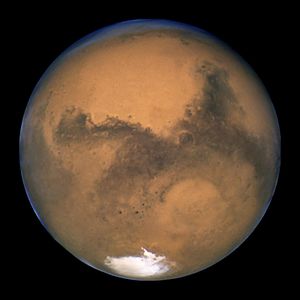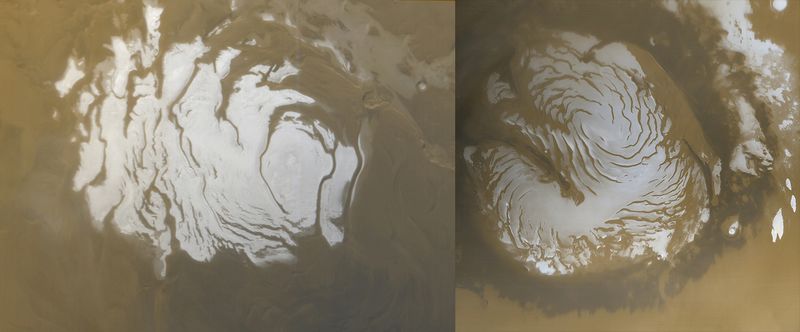Mars
Contents
hideExplanation
Mars is the fourth planet from the Sun that is often dubbed as the red planet. As the surface of Mars is covered with iron oxide, the surface of the planet is seen with a reddish hue. Next to Venus, Mars has been a candidate of interest for humans for terraforming and colonization. With a rotational period of roughly 24 hours and an orbital period of 687 Earth days, Mars is similar to Earth in many ways. The axial tilt of the planet is 25°, making seasons possible on there. Due to the axial tilt, Mars has polar ice caps made up of ice and dry ice. Seasonal changes also give rise to the Martian winds that blow from the poles, reaching speeds as high as 400 km/h. The winds further forms cirrus clouds, due to the transportation of the water vapour and dust.
The atmosphere of Mars is rich in carbon dioxide, with about 96% of total concentration. With trace amounts of oxygen and water, other constituents include argon, nitrogen, methane and carbon monoxide.[1] But due to the lack of a magnetosphere, most of the atmosphere is stripped off by the solar winds.[2] As the result of the solar wind interactions, the atmospheric pressure on Mars is only 600 pascals, which is 0.6% of Earth's atmospheric pressure at sea level of 101.3 kilopascals. The temperature on the planet reaches as high as 300 K in the day times and reaches as low as 200 K at night times.
Frequently Asked Questions
Is there water on Mars?
Yes, water exists on Mars, mostly in the form of water ice at the poles. There are few pieces of evidence of orbital spectroscopic measurements that show that water vapour is present in the atmosphere too.[3] It is also believed that there could be water in the form of ice trapped in the subsurface of the planet.
Melting all the ice at the poles would fill the entire planet with 35 metres of water. But because of the low atmospheric pressure and low surface temperature, liquid water cannot exist on the red planet.
Could Mars support life?
Mars could support life if the planet could be terraformed. Naturally, there is no evidence of life on Mars yet. However, as Mars has no plate tectonics and remained dormant for a long time, there have been theoretical studies focusing on models about the possibility of abiogenesis on Mars. In the future, if humans were to colonize Mars, the only way to survive there is by massively terraforming the planet while living in Mars habitats with artificial greenhouses.
How to grow plants on Mars?
Growing plants on Mars is technically feasible by overcoming some challenges posed by the Martian environment. The primary challenges are the lack of nitrogen and abundance of perchlorates in the Martian regolith. Plants depend on nitrogen fixation if they were to be grown on the regolith instead of hydroponics. Legumes can be used to deal with the nitrogen fixation problem as they can house symbiotic bacteria that does the atmospheric nitrogen fixation. By using perchlorate consuming microbes like bacteria, the perchlorate problem can be solved too. But due to the low surface temperature and atmospheric pressure on Mars, the only possible solution to grow plants is inside an artificial greenhouse.
References
- Jump up ↑ Mahaffy, P. R. et al. "Abundance And Isotopic Composition Of Gases In The Martian Atmosphere From The Curiosity Rover". Science 341.6143 (2013): 263-266. Web. 13 Jan. 2017.
- Jump up ↑ Lundin, R. "Solar Wind-Induced Atmospheric Erosion At Mars: First Results From ASPERA-3 On Mars Express". Science 305.5692 (2004): 1933-1936. Web. 13 Jan. 2017.
- Jump up ↑ Titov, D. V. et al. "Measurements Of The Atmospheric Water Vapor On Mars By The Imager For Mars Pathfinder". Journal of Geophysical Research: Planets 104.E4 (1999): 9019-9026. Web. 13 Jan. 2017.


